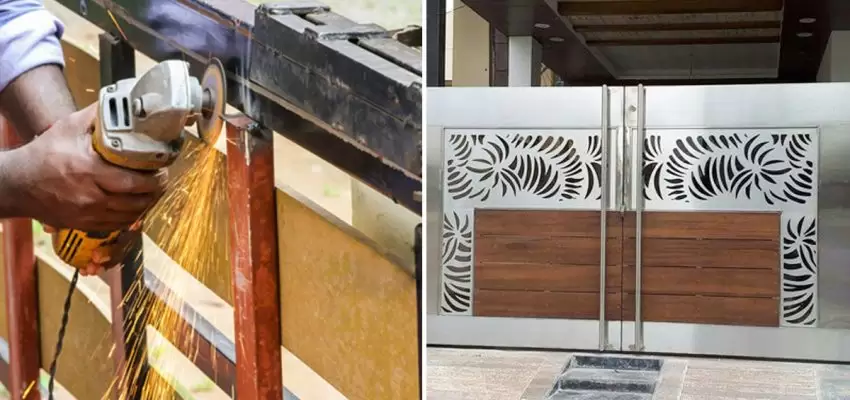Gated perimeters provide a vital first layer of protection securing facilities from unauthorized access, theft, and vandalism. Custom fabricated gates control passage into areas ranging from commercial warehouses to apartment complexes to industrial sites. With crime a continual societal concern, quality gates act as psychological deterrents and physical barriers buying critical response time against intrusions. The specialized skills of reputable gate fabricators directly combat security threats across communities through precision gate solutions matched to vulnerability risks.
Post your Requirement
| Term | Definition |
|
Gate Fabricators |
Gate fabricators are professionals or companies specializing in the fabrication, design, and installation of gates. They work with various materials such as steel, aluminum, iron, and wood to create custom gates tailored to the client’s specifications and needs. Gate fabricators may also provide maintenance and repair services for existing gates. |
|
Hire Gate Fabricators |
Hiring gate fabricators involves selecting and contracting professionals or companies to design, fabricate, and install gates for residential, commercial, or industrial properties. This process typically involves researching and comparing different fabricators, reviewing their portfolios and customer reviews, obtaining quotes, and selecting the most suitable fabricator for the project. |
|
Gate Fabricators Online |
Gate fabricators online refer to the availability of gate fabrication services through online platforms or websites. Customers can browse through various fabricators, view their portfolios, read reviews, and request quotes online. This allows for convenient access to gate fabrication services and facilitates the hiring process for clients looking to install gates for their properties. |
This tabular format provides a concise overview of the key security priorities considered by gate fabricators when designing and implementing security solutions for various facilities, helping clients understand the factors involved in ensuring effective security measures.
| Security Priority |
Description |
|
Facility Type & Valuables at Risk |
Gate fabricators assess the type of facility and the valuables at risk within it. This includes considering whether it’s a high-traffic retail store, an inner-city distribution center for expensive goods, or other establishments with varying security needs based on the assets they hold. |
|
Frequency and Volume of Traffic |
Gate strategies are tailored based on the frequency and volume of traffic the facility experiences. This includes analyzing the flow of people and vehicles to determine the appropriate level of access control, visibility, and impedance required to address security risks effectively. |
|
Existing Defensive Measures in Place |
Gate fabricators evaluate the existing defensive measures in place, such as surveillance systems, fences, and other security features. This assessment helps determine how gates can complement or enhance the existing security infrastructure to provide comprehensive protection against threats. |
|
Crime Data for Immediate Area |
Gate fabricators consider crime data for the immediate area surrounding the facility to understand the specific security threats and challenges it faces. This information informs the design and implementation of gate strategies tailored to address the prevailing security risks effectively. |
|
Budget Constraints |
Gate strategies are developed while considering budget constraints. Fabricators work within budget limitations to design and implement security solutions that prioritize essential features while maximizing cost-effectiveness. This ensures that clients can achieve effective security without exceeding their financial limitations. |
|
Access Control & Monitoring |
Gate fabricators design specialized portals with varying levels of access control, ranging from manual operation to sophisticated automation with electronic readers and remote monitoring capabilities. Access control measures are matched to security risks to deter unauthorized entry and provide accountability through monitoring. |
| Visibility & Lighting | Gates are designed to enhance visibility with transparent sections and LED light installations along perimeters. This aids in proactive threat identification by promoting surveillance of surrounding zones and quick detection of suspicious activity, particularly during nighttime hours when visibility may be limited. |
| Impedance & Deflection | Gate construction incorporates materials and features that resist forced entry and provide valuable delay time against intruders. Impedance measures such as reinforced frames and anti-ram barriers discourage unauthorized access by increasing the difficulty of breaching perimeter defenses, thereby enhancing security. |
| Psychological Deterrence | Gates serve as a psychological deterrent by presenting an imposing barrier that signals tough resistance to criminal activity. Vigilantly patrolled barriers and signage warning of surveillance and swift law enforcement response dissuade potential intruders and steer mischief away from protected properties. Maintaining a perception of heightened security is crucial for deterring crime. |
| Ongoing Maintenance | Proper maintenance of gates ensures their continual optimal function and longevity in protecting assets. Gate fabricators guide inspection routines and offer emergency repair services to address vulnerabilities promptly. Well-maintained gates sustain critical security integrity over the long term. |
Now let us explain each of the points in detail:
1. Defining Security Priorities:
An expert gate fabricator begins every project by defining security priorities based on factors like:
- Facility type & valuables at risk.
- Frequency and volume of traffic.
- Existing defensive measures in place.
- Crime data for the immediate area.
- Budget constraints.
A high-traffic retail store in a sleepy small town requires a radically different gate strategy than an inner-city distribution center for expensive goods. Gate experts tailor combinations of access control, visibility, impedance, and other capabilities to address context-specific risks.
2. Access Control & Monitoring:
Gated access relies firstly on controlled points of entry. Gate fabricators design specialized portals ranging from electronics-free manual operation to sophisticated automation with badge/pin code readers, sensors, and remote monitoring. Integrated tracking of individuals passing through gates combined with video surveillance provides monitoring and accountability. Even manual gates often integrate locks, buzzer systems, guard stations, or intercoms for screening. Matching access measures to risk deters unauthorized passage.
3. Visibility & Lighting:
“See something, say something” constitutes another vital crime deterrence tactic gates facilitate through visibility-promoting designs. Transparent sections in gates, fences, and barriers allow monitoring of surrounding zones for fast response. Bright LED light installations mounted along gate perimeter areas help observers quickly spot any suspicious activity at night. Visibility-enhancing gate features aid proactive threat identification.
4. Impedance & Deflection:
While gates provide access as needed, their hardened steel construction also resists forced entry for valuable delay time. Threat impedance refers to the difficulty intruders face breaching perimeter defenses like cut/climb-resistant metal gates mounted in reinforced frames. State-of-the-art materials like hardened steel with protective coatings increase strength against power tools and torch attacks. Customized anti-ram gates and bollards provide vehicle deflection as well. Impedance discourages criminals from lacking specialized breaching equipment and skills.
5. Psychological Deterrence:
Beyond physical security measures, gates present an imposing psychological message that criminal plots will meet tough resistance. Solid barriers patrolled by vigilant guards deter opportunists from scanning for easy ingress/egress points. Signage warning of 24-hour recording and quick law enforcement response also persuades would-be thieves to look elsewhere. Even decorative gates imply constant monitoring occurs on protected properties. This perception of heightened security and increased likelihood of capture steers mischief away.
6. Ongoing Maintenance:
Properly maintaining gates ensures continual optimal function protecting assets over decades. But failing gates forfeit all the designed safety they once provided. Responsible gate fabricators coach clients on inspection routines to spot damage, assess alignments, lubricate components, and confirm electronics operation. Emergency repair dispatch remains on call if vulnerabilities appear between maintenance intervals. Well-maintained gates sustain critical security integrity.
Conclusion
Skilled gate fabricators build far more than simple portals – they construct the frontline framework reinforcing safety and security within communities. By aligning tailored access control solutions to site-specific facility risks, gate experts contribute tangible systems protecting life and property against intrusion threats. Quality gates engineered to match context-appropriate security needs continue vigilantly defending people and valuables 24/7 through robust steel barriers, monitoring integration, visibility, and psychological impedance. Investing in properly designed and maintained gates pays perpetual dividends through crime deterrence and prompt incident response. contributing to safer cities for all citizens.























Post A Comment